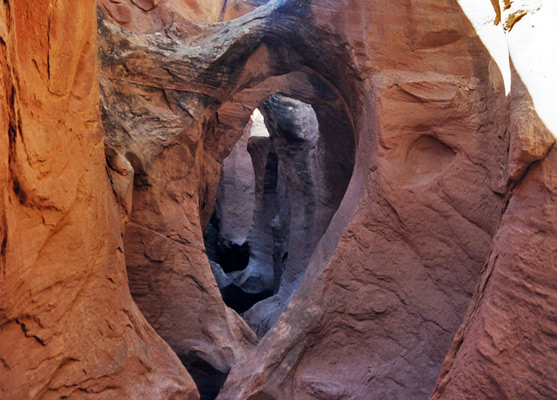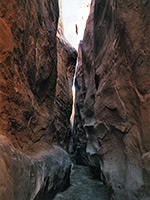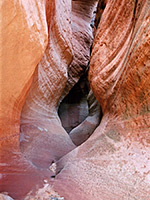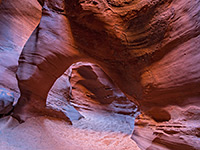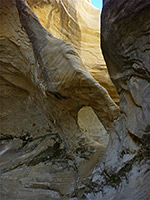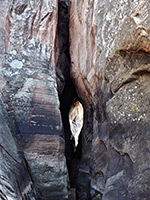Peekaboo Gulch
Minor tributary of Dry Fork of Coyote Gulch forming a short slot at its southern end, containing sharp fins, interlinked potholes several small arches
Length: 1.1 miles, to the north end of the lower narrows
Difficulty: Easy
Management: BLM
Rocks: Navajo sandstone
Season: All year - whenever the approach road is accessible
Trailhead: End of a 1.6 mile track, forking off Hole-in-the-Rock Road 26 miles south of UT 12
Rating (1-5): ★★★★★
Difficulty: Easy
Management: BLM
Rocks: Navajo sandstone
Season: All year - whenever the approach road is accessible
Trailhead: End of a 1.6 mile track, forking off Hole-in-the-Rock Road 26 miles south of UT 12
Rating (1-5): ★★★★★
Peekaboo Gulch is a small drainage - for the most part just a sandy wash, it eventually enters a half mile narrows section, very twisting and convoluted though only a few meters deep. The gulch is most famous because of the last 100 meters, before the junction with Dry Fork of Coyote Gulch - here the ravine cuts deeper into the red Navajo sandstone, forming a series of interlinked potholes, extravagant swirls and fins of rock, and several arches; these different openings and the many corners and crevices account for the curious name of this canyon. One hour is enough to see all of the lower narrows.

The canyon is the first tributary joining Dry Fork of Coyote Gulch downstream of the usual entrance point to that canyon.
6 views of Peekaboo Gulch.
There is usually a pool of murky water beneath the end of Peekaboo Gulch, which may be up to 3 feet deep, with a near vertical rock wall about 10 feet high beyond. Several foot holes have been cut into this rock but these are rather worn and muddy, and climbing up can be quite difficult, especially if exploring alone. Piling stones in the pool helps to gain height and makes the ascent a little easier. Above is another watery pothole and beyond that is a succession of pools, each a few feet higher up, with more slippery rocks to scramble up and over; several points are rather tricky to negotiate. This lower section of the canyon has the sandstone arches and the best rock formations.
The slot canyon becomes shallower and the going more straightforward, and there are several places where climbing up to the plateau at either side is possible. An alternative way to reach this point is to walk a little way up or down the main Dry Fork canyon until the cliffs fall away, then walk over slickrock towards the gulch; the lower section is easier to explore downstream. In the other direction, Peekaboo Gulch continues for some distance through more very narrow, twisting passages that are shallow but still with pretty, eroded features. These too are liable to be very muddy but exploring this section presents no real difficulties. The open wash beyond eventually splits and has further short narrows sections but most visitors do not walk this far.
Topographic Map of Peekaboo Gulch

Location
The canyon is the first tributary joining Dry Fork of Coyote Gulch downstream of the usual entrance point to that canyon.
Photographs
6 views of Peekaboo Gulch.
Peekaboo Gulch Route Description
There is usually a pool of murky water beneath the end of Peekaboo Gulch, which may be up to 3 feet deep, with a near vertical rock wall about 10 feet high beyond. Several foot holes have been cut into this rock but these are rather worn and muddy, and climbing up can be quite difficult, especially if exploring alone. Piling stones in the pool helps to gain height and makes the ascent a little easier. Above is another watery pothole and beyond that is a succession of pools, each a few feet higher up, with more slippery rocks to scramble up and over; several points are rather tricky to negotiate. This lower section of the canyon has the sandstone arches and the best rock formations.
Exit Route
The slot canyon becomes shallower and the going more straightforward, and there are several places where climbing up to the plateau at either side is possible. An alternative way to reach this point is to walk a little way up or down the main Dry Fork canyon until the cliffs fall away, then walk over slickrock towards the gulch; the lower section is easier to explore downstream. In the other direction, Peekaboo Gulch continues for some distance through more very narrow, twisting passages that are shallow but still with pretty, eroded features. These too are liable to be very muddy but exploring this section presents no real difficulties. The open wash beyond eventually splits and has further short narrows sections but most visitors do not walk this far.
Peekaboo Gulch - Similar Hikes
All Contents © Copyright The American Southwest | Comments and Questions | Contribute | Affiliate Marketing Disclosure | Site Map
